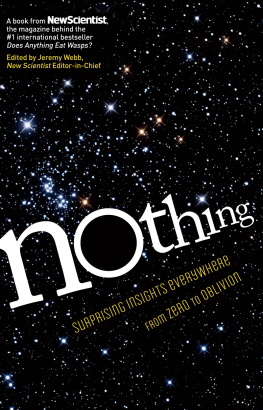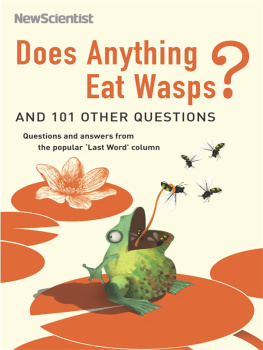Why Are Orangutans Orange?
Science questions in pictures
with fascinating answers

Why Are Orangutans Orange?
Science questions in pictures
with fascinating answers
More questions and answers
from the popular Last Word column
edited by Mick OHare

First published in Great Britain in 2011 by
Profile Books Ltd
3A Exmouth House
Pine Street
Exmouth Market
London EC1R 0JH
www.profilebooks.com
10 9 8 7 6 5 4 3 2 1
Copyright New Scientist 2011
The moral right of the authors has been asserted.
All rights reserved. Without limiting the rights under copyright reserved
above, no part of this publication may be reproduced, stored or introduced
into a retrieval system, or transmitted, in any form or by any means
(electronic, mechanical, photocopying, recording or otherwise), without the
prior written permission of both the copyright owner and the publisher of
this book.
A CIP catalogue record for this book is available from the
British Library.
ISBN 978 1 84668 507 1
eISBN 978 1 84765 755 8
Text design by Sue Lamble
Typeset in Palatino by MacGuru Ltd
info@macguru.org.uk
Printed in China through Asia Pacific Offset Ltd
Contents
Introduction
OK, we admit it, theyre cute. Thats why they are on the front of the book. But when asked, we had no idea why orangutans were a strange orange colour one that didnt even seem to match their environment. It was a long time before we received any response to the question too, suggesting that even the experts were a little unsure. But now we think we know turn to page 30 to find out.
Youll also discover among these pages why tigers have stripes rather than spots, why blue-footed boobies have, erm, blue feet and whether kittiwakes can fly upside down. And its not all about animals. We have the lowdown on any number of clouds, strange bubbles and weird ice and all in glorious colour.
Readers of our earlier books such as Why Dont Penguins Feet Freeze? and Does Anything Eat Wasps? will notice a difference in this latest collection of questions and answers from New Scientists Last Word column photographs: and lots of them.
Most havent been supplied by professionals. In fact, nearly all have been taken by readers of The Last Word column in New Scientist magazine and on its website. Some of the photographs are extraordinary, many are unique and some are a bit fuzzy. But we can handle that because they tell the visual story of some extraordinary phenomena, taken on the run by members of the public.
And that is the essence of this book: a celebration of the wonder of our world that any inquisitive person lucky enough to be in the right place at the right time can witness and record if we are prepared to keep our eyes open. Specialists in their fields have spent years waiting to capture these moments but they have been beaten to it by readers of New Scientist and its books.
All of which means we can now tell you the story of why flies sometimes explode, what you should do when your hair stands on end (and why its very, very important to do it quickly) and why Mount Fuji sometimes appears to be wearing a hat.
If you have any similar images that you have captured somewhere in the world from your back garden to coldest Antarctica and have always wondered what on earth they show, The Last Word can help. Every week hundreds of questions pour into our offices, some with photographs, others without. You can add yours to the list, or help us answer the ones we are still puzzling over. Visit www.newscientist.com/lastword to ask a question, or help us answer one. And buy the magazine to check out our weekly page. You could even appear in the next book (or at least your photograph could).
Mick OHare
1 All creatures great and peculiar

Happy feet
The blue-footed booby is an extraordinary-looking bird. It has fairly dull plumage but strikingly coloured blue legs and feet. What could be the evolutionary benefit of such a conspicuous feature? Both sexes have blue feet so they dont seem to be for impressing potential mates.
Sam Moore
London, UK

Although not obvious at first sight, during courtship blue-footed boobies (Sula nebouxii) have different-coloured feet depending on their sex: male feet are brighter and more of a greenish-blue, while the females have duller feet that are bluish.
The birds exhibit their feet to prospective partners in a series of courtship displays. These include a kind of ritualised strutting around that allows them to show off their feet, plus stylised or salute landings which serve the same purpose.
I am a member of a research group that studies the sexual behaviour of the blue-footed booby. In one experiment, we altered the colour of the courting males feet and recorded the females response. Females paired to males with duller feet were less enthusiastic about courtship and less likely to copulate compared with females paired to males with normal, brightly coloured feet. Similarly, when we altered the females feet to a duller blue, males became less interested in courting them. Birds in poor health often have dull blue feet.
Whats more, females whose mates had dull blue feet produced smaller eggs, and their chicks had a poorer immune response compared with normal females. This may sound surprising, but it is in accordance with theoretical expectations.
All this suggests that males are probably under strong selection pressure to maintain greenish-blue feet during courtship. This will ensure not only that they copulate successfully but also that their mates will lay big, healthy eggs. Overall, our results suggest that foot colour is a trait maintained by mutual male and female preferences.
Roxana Torres
Institute of Ecology
National Autonomous University of Mexico
Both male and female Sula nebouxii have blue feet, but it is the male that presents his feet prominently in courtship. This, in effect, is a way of saying that he is of the same species as the female.
I cannot offer any specific reason why the blue-footed booby has blue feet, but I would point out that foot colour does seem to be significant in the genus there is an equally striking red-footed booby, Sula sula. This suggests that as members of the genus evolved, they adapted to different ecological niches which, in turn, meant that there was an advantage in the birds splitting into different tribes that could only mate with their own kind.
This is an example of what is called sympatric evolution, where one species evolves into two within a shared territory. In contrast, allopatric evolution occurs because populations become isolated from each other. For sympatric evolution to succeed, it is essential that some sort of difference between the species arises so that a bird can distinguish between a bird of a related species and one of its own kind.
Next page















 Happy feet
Happy feet